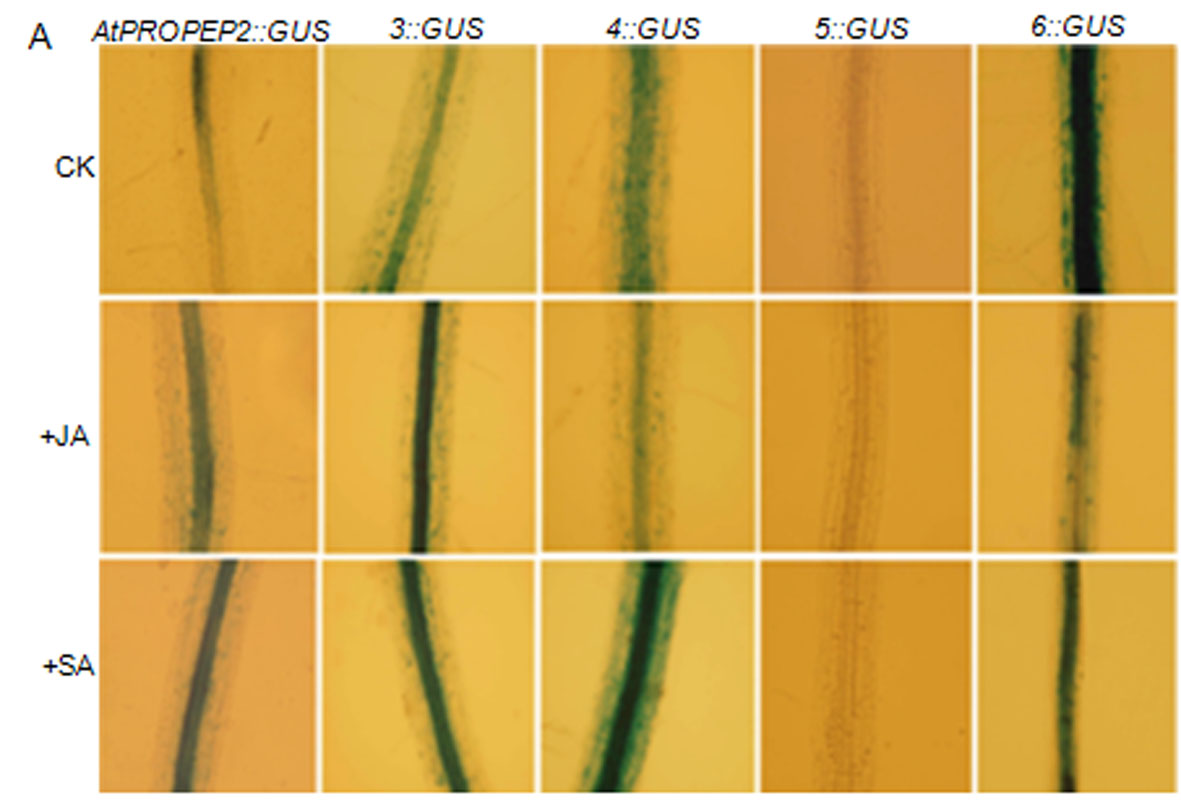拟南芥短肽激素PROPEP基因家族在根生长中的作用机理
- 1内蒙古大学, 呼和浩特 010021
2内蒙古农业大学附属小学, 呼和浩特 010018
收稿日期: 2015-05-18
录用日期: 2015-09-04
网络出版日期: 2016-03-31
基金资助
内蒙古自然科学基金(2013MS0507)
Mechanism of Arabidopsis Short Peptide Hormones PROPEP Gene Family in the Root Growth
- 1Inner Mongolia University, Hohhot 010021, China
2The Elemental School Affiliated to Inner Mongolia Agricultural University, Hohhot 010018, China
Received date: 2015-05-18
Accepted date: 2015-09-04
Online published: 2016-03-31
摘要
AtPROPEP是拟南芥(Arabidopsis thaliana)具有7个成员的基因家族, 编码内源短肽激素。AtPROPEP基因家族编码的蛋白质C端23个氨基酸短肽能够被2个同源激酶受体AtPEPR1和AtPEPR2识别并结合, 引起下游反应。然而, 对于该家族成员AtPROPEP2,3−6的表达对茉莉酸(JA)和水杨酸(SA)的响应以及在根生长中的作用并不清楚。GUS染色和定量RT-PCR分析结果表明, AtPROPEP2-6的表达对于JA和SA的响应不同, 暗示着它们可能通过不同的方式参与植物的先天免疫反应。AtPROPEP3和AtPROPEP4过表达植株的表型分析表明, AtPROPEP3和AtPROPEP4促进拟南芥根的生长。

本文引用格式
李冬梅 , 王路雅 , 张澜玥 , 帖子阳 , 毛惠平 . 拟南芥短肽激素PROPEP基因家族在根生长中的作用机理[J]. 植物学报, 2016 , 51(2) : 202 -209 . DOI: 10.11983/CBB15088
Abstract
AtPROPEP is a 7-member gene family in the Arabidopsis genome that encodes an endogenous peptide hormone. The C-terminal of the encoded proteins, about 23 amino acids, can be recognized by the corresponding receptors AtPEPR1 and AtPEPR2, which in turn evoke downstream cascades. Whether AtPROPEP2-6 respond to jasmonic acid and salicylic acid is unknown, as is their roles in root development. In this study, GUS staining and quantitative RT-PCR revealed that AtPROPEP2-6 expression had various responses to jasmonic acid and salicylic acid treatments, which implies their roles in innate immunity. In addition, Arabidopsis overexpressing AtPROPEP3 and AtPROPEP4 had significant longer roots than did the wild type.

Key words: Arabidopsis; AtPROPEP; root; peptide; jasmonic acid; salicylic acid
参考文献
| [1] | 李新锋, 赵淑清 (2004). 转基因植物中报告基因GUS的活性检测及其应用. 生命的化学 24, 71-74. |
| [2] | Bartels S, Lori M, Mbengue M, van Verk M, Klauser D, Hander T, B?ni R, Robatzek S, Boller T (2013). The family of Peps and their precursors in Arabidopsis: dif- ferential expression and localization but similar induction of pattern-triggered immune responses. J Exp Bot 64, 5309-5321. |
| [3] | Gijrlach J, Volrath S, Knauf-Beiter G, Hengy G, Beckhove U, Kogel KH, Oostendorp M, Staub T, Ward E, Kessmann H, Ryals J (1996). Bekothiadiazdle, a novel class of inducers of systemic acquired resistance, activates gene expression and disease resistance in wheat. Plant Cell 8, 629-643. |
| [4] | Huffaker A, Pearce G, Ryan CA (2006). An endogenous peptide signal in Arabidopsis activates components of the innate immune response. Proc Natl Acad Sci USA 103, 10098-10103. |
| [5] | Huffaker A, Ryan CA (2007). Endogenous peptide defense signals in Arabidopsis differentially amplify signaling for the innate immune response. Proc Natl Acad Sci USA 104, 10732-10736. |
| [6] | Kuc J (1982). Induced immunity to plant disease. Bioscience 32, 854-860. |
| [7] | Ma C, Guo J, Kang Y, Doman K, Bryan AC, Tax FE, Yamaguchi Y, Qi Z (2014). AtPEPTIDE RECEPTOR2 mediates the AtPEPTIDE1 induced cytosolic Ca2+ rise which is required for the suppression of Glutamate Dumper gene expression in Arabidopsis roots. J Integr Plant Biol 56, 684-694. |
| [8] | Pearce G, Moura DS, Stratmann J, Ryan CA (2001). Production of multiple plant hormones from a single polyprotein precursor. Nature 411, 817-820. |
| [9] | Ross AF (1961). Systemic acquired resistance induced by localized virus infections in plants. Virology 14, 340-358. |
| [10] | Uknes S, Mauch-Mani B, Moyer M, Potter S, Williams S, Dincher S, Chandler D, Slusarenko A, Ward E, Ryals J (1992). Acquired resistance in Arabidopsis. Plant Cell 4, 645-656. |
| [11] | Van Loon LC, Van Kammen A (1970). Polyacrylamide disc electrophoresis of the soluble proteins from Nicotiene tabacum var. samsun and Samnkun NN. II. Changes in protein constitution after infection with tobacco mosaic virus. Virology 40, 199-211. |
| [12] | Vijayan P, Shockey J, Lévesque CA, Cook RJ, Browse J (1998). A role for jasmonate in pathogen defense of Arabidopsis. Proc Natl Acad Sci USA 95, 7209-7214. |
| [13] | Ward ER, Uknes SJ, Williams SC, Dincher SS, Wiederhold DL, Alexander DC, Ahl-Goy P, Metraux JP, Ryals JA (1991). Co-ordinate gene activity in response to agents that induce systemic acquired resistance. Plant Cell 3, 1085-1094. |
| [14] | Yamaguchi Y, Huffaker A, Bryan AC, Tax FE, Ryan CA (2010). PEPR2 is a second receptor for the Pep1 and Pep2 peptides and contributes to defense responses in Arabidopsis. Plant Cell 22, 508-522. |
| [15] | Zhang X, Henriques R, Lin SS, Niu QW, Chua NH (2006). Agrobacterium-mediated transformation of Arabidopsis thaliana using the floral dip methods. Nature Protocols 1, 641-646. |
| [16] | Zimmerli L, Stein M, Lipka V, Schulze-Lefert P, Some- rville S (2004). Host and non-host pathogens elicit differ- ent jasmonate/ethylene responses in Arabidopsis. Plant J 40, 633-646. |